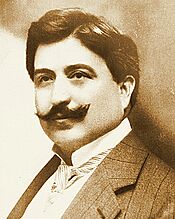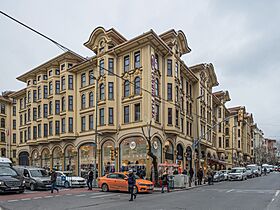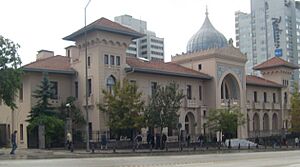Mimar Kemaleddin facts for kids
Quick facts for kids
Ahmed Kemaleddin
|
|
|---|---|

An old photograph of Mimar Kemaleddin
|
|
| Born | 1870 |
| Died | 13 July 1927 |
| Nationality | Turkish |
| Alma mater | Hendese-i Mülkiye Mektebi Technische Hochschule Charlottenburg |
| Occupation | Architect |
| Children | İlhan Mimaroğlu |
| Buildings | Tayyare Apartments, Ankara Palas, Bebek Mosque |

Ahmed Kemaleddin (Ottoman Turkish: احمد كمال الدين; 1870 – 13 July 1927), known to many as Mimar Kemaleddin (Architect Kemaleddin), was a famous Turkish architect. He was one of the most important people in the First National Architectural Movement, working alongside Vedat Tek.
Contents
Early Life and Learning
Ahmed Kemaleddin was born in 1870 in Acıbadem, a neighborhood in Istanbul. His father was a naval captain. Ahmed started primary school in 1875. Later, he moved to Crete for a short time because of his father's work. He soon returned to Istanbul and finished high school.
In 1887, when he was 17, he joined the School of Civil Engineering, which is now Istanbul Technical University. He was a very bright student and graduated with honors in 1891. After graduating, he stayed at the university as an assistant. During this time, he also started his own architecture office.
In 1895, a German architect named August Jachmund, who designed the Sirkeci Terminal in Istanbul, encouraged him. With a special scholarship from the government, Ahmed went to Germany. He studied architecture for two years at the Berlin Institute of Technology in Berlin. He then worked in different architecture offices for two and a half years to gain experience.
When he came back to Turkey in 1900, he continued working at the university. He took over August Jachmund's teaching role. In 1908, he helped create the first professional group for engineers and architects in the Ottoman Empire. It was called the "Society of Ottoman Architects and Engineers."
Designing Great Buildings
Even as a student, Kemaleddin was very hardworking and creative. He was more interested in architecture than engineering. His teacher, Professor Jasmund, even chose him as his assistant.
Kemaleddin was always open to new ideas and trying different things in his designs. He was also very confident in his own abilities as an architect. He was influenced by his time in Germany, but he also looked at many other styles. For example, some of his early buildings showed Art Nouveau influences. Others had a touch of French public housing or an Oriental look. He even mixed different styles in some of his works.
Kemaleddin's buildings often showed his strong beliefs and ideas. His creativity helped him turn these ideas into a unique style of architecture. His hard work, good organization, and teaching skills helped him create a whole new school of architecture.
A Master of Restoration
In 1909, Kemaleddin became the head of architecture at the Imperial Ministry of Foundations. This job allowed him to design new buildings, which he loved. But it also gave him a special chance to learn by working on old, historical buildings. He wisely used both types of work to help each other grow.
He saw restoring old buildings as a way to understand traditional architecture. This helped him create new ideas for modern designs. He was a pioneer in this field, setting new rules for restoration when they weren't clear before.
Kemaleddin knew that restoring buildings was more than just fixing them. He taught others how to do it properly. He was one of the first to use a scientific approach to restore many old Ottoman buildings.
He worked with great passion on the Yeni Cami Hunkar Gathering Place. But his most famous restoration project was the Mescid-i Aksa and Harem-i Serif in Jerusalem. His amazing work on the Mescid-i Aksa earned him international praise. He even received an award from the Royal Institute of British Architects!
Teaching and Helping Others
After graduating, Kemaleddin joined the teaching staff at his old school. He taught technology and architecture and was Professor Jasmund's assistant. When he returned from Germany, he continued teaching. He taught hundreds of students at various schools, including the Academy of Fine Arts and the Academy of Engineering.
He taught many different subjects, from architecture to drawing and even calligraphy. What was clear was that he shared his passion with his students.
When he worked at the Ministry of Foundations, he brought his students to the Building and Reparation Technological Assembly. This was to help meet the high demand for new buildings. This team of talented architects and engineers he chose became like a school itself. Their office became a center for creating designs in the "national architecture" style.
Kemaleddin also played a key role in starting the Ottoman Society of Architects and Engineers. He even wrote the newspaper announcement calling for the first meetings. His last important role was being a member, and later the president, of the Council of Fine Arts, which was created in 1926.
Important Buildings and Projects
Kemaleddin designed many important buildings throughout his career. Some of his famous works include:
- Tayyare Apartments, Istanbul (1922): These apartments were later turned into a luxury hotel.
- Istanbul 4th Vakıf Han (1926): This building also became a five-star hotel.
- Bebek Mosque, Istanbul (1913)
- Eyüp Anadolu High School, Istanbul
- Çapa Anadolu Teachers' High School, Istanbul
- Şemsi Pasha Primary School
- Çamlıca Girls' High School
- Bostancı Mosque, Istanbul
- Yeşilköy Mosque, Istanbul
- Reşadiye School (now Eyüp Middle School), Istanbul
- Library of Istanbul University's Faculty of Letters (1913)
He also designed railway stations, including the Plovdiv Central railway station (1908) and the Edirne Railway Station (1914). He even designed a girls' high school in Edirne in 1908.
Kemaleddin was inspired by Ottoman classical architecture. He tried to create a new style by mixing features from German and Ottoman designs. He used arches, special roof edges, and tiles on the outside of his buildings. He also focused on symmetry and traditional styles, often adding small towers and decorative edges.
Notable Tombs
Kemaleddin designed several tombs, which are special buildings for graves. These include:
- Tomb of Sultan Reshad
- Tomb of Gazi Osman Pasha
- Tomb of Mahmud Shevket Pasha (1913): This tomb is unique. It has a square shape with a dome and steps on three sides. It also has another part next to it.
- Tomb of Ali Rıza Pasha
- Tomb of Hüsnü Pasha
- Tomb of Ahmed Cevad Pasha, Istanbul (1901)
Ankara Palas Hotel
The Ankara Palas Hotel was a very important project for Kemaleddin. Another architect, Vedad Bey, started the design in 1924. But when he left, Kemaleddin took over and finished the design. The hotel opened in 1927.
This hotel was a key place for political and social events in Ankara, especially when the Republic of Turkey was new. It hosted many important guests. The building has a grand look with pointed arches and a domed entrance, giving it an Oriental feel. It also has a beautiful ballroom that gets natural light.
Turkish State Railways Building
This building was Kemaleddin Bey's last design. The construction started a month after he passed away and was finished in 1928. It was originally planned as apartments for railway workers but ended up being used by the railway administration.
The building was meant to be a large apartment complex around a courtyard. However, only one part of it was completed. It has a simple but strong look with flat, square windows. The decorative ironwork on the main gate and above it is very impressive.
Gazi Institute of Education

The Gazi Institute of Education building is one of Kemaleddin Bey's final works. He completed its design in 1927, and the building was finished in 1930. The school started teaching programs in the same year.
This large building has four floors, including a basement. It has two inner courtyards and a system of corridors. The middle part of the building is five stories high, with a sixth floor used as an observatory.
The main entrance has a large porch with huge columns and tall arches. The building looks magnificent, but the details, like the patterned columns at the entrances, make it feel welcoming on a human scale.
His Legacy and Honors
Ahmed Kemaleddin died on July 13, 1927, in Ankara. He was 57 years old and passed away at the construction site of the Ankara Palas from a brain hemorrhage. He left behind his wife, Sabiha, and his son, İlhan Mimaroğlu, who became a famous composer.
His body was moved to Istanbul and buried in the Karacaahmet Cemetery. Years later, his grave had to be moved because a road was being built. It was reburied at the graveyard of Bayezid II Mosque. His grave was found again in the 1990s and restored in 2007.
To honor him, a street in Istanbul near the Sirkeci Terminal is named after him. In 2009, his picture was put on the back of the 20-lira Turkish lira banknote. The banknote also shows one of his major works, the rectorate building of Gazi University in Ankara.
Images for kids
-
Grave of Mimar Kemaleddin Bey at the cemetery of the Bayezid II Mosque in Istanbul




